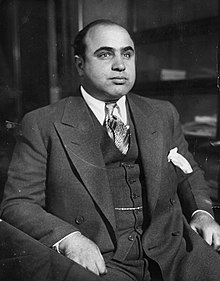Public enemy
This article needs additional citations for verification. (February 2012) |


"Public enemy" is a term which describes individuals whose activities are seen as criminal and extremely damaging to society.
Examples of notable people referred to as Public Enemies were Al Capone in the 1930s.
Origin and usage
[edit]The expression dates back to Roman times.[1] The Senate declared emperor Nero a hostis publicus in AD 68.[2] Its direct translation is "public enemy". Whereas "public" is currently used in English in order to describe something related to collectivity at large, with an implication towards government or the State, the Latin word publicus could, in addition to that meaning, also refer directly to people, making it the equivalent of the genitive of populus ("people"), populi ("popular" or "of the people"). Thus, "public enemy" and "enemy of the people" are, etymologically, near-synonyms.
The phrase is attested in the 17th century in the United Kingdom.[3]
The words ennemi du peuple were extensively used during the French Revolution. On 25 December 1793, Robespierre stated: "The revolutionary government owes to the good citizen all the protection of the nation; it owes nothing to the Enemies of the People but death".[4] The Law of 22 Prairial in 1794 extended the remit of the Revolutionary Tribunal to punish "enemies of the people", with some political crimes punishable by death, including "spreading false news to divide or trouble the people".[5]
US Public Enemy Era
[edit]The modern use of the term was first popularized in April 1930 by Frank J. Loesch, then chairman of the Chicago Crime Commission, to publicly denounce Al Capone and other organized crime gangsters.[6]
In 1933, Loesch recounted the origin and purpose of the list:
I had the operating director of the Chicago Crime Commission bring before me a list of the outstanding hoodlums, known murderers, murderers which you and I know but can't prove, and there were about one hundred of them, and out of this list I selected twenty-eight men. I put Al Capone at the head and his brother next, and ran down the twenty-eight, every man being really an outlaw. I called them Public Enemies, and so designated them in my letter, sent to the Chief of Police, the Sheriff [and] every law enforcing officer. The purpose is to keep the publicity light shining on Chicago's most prominent, well known and notorious gangsters to the end that they may be under constant observation by the law enforcing authorities and law-abiding citizens.[7]
All of those listed were reputed to be gangsters or racketeers and most were rum-running bootleggers. Although all were known to be consistent law breakers (most prominently in regard to the widely broken Eighteenth Amendment to the United States Constitution banning alcohol), none of those named were fugitives or were actively wanted by the law at that specific moment. The list's purpose was clearly to shame those named and to encourage authorities to prosecute them.
The phrase was later appropriated by J. Edgar Hoover and the FBI, who used it to describe various notorious fugitives they were pursuing throughout the 1930s. Unlike Loesch's use of the term, the FBI's "Public Enemies" were wanted criminals and fugitives who were already charged with crimes. Among the criminals whom the FBI called "public enemies" were John Dillinger, Baby Face Nelson, Bonnie and Clyde, Pretty Boy Floyd, Machine Gun Kelly, Ma Barker, and Alvin Karpis.
The term was used so extensively during the 1930s that some writers call that period of the FBI's early history the "Public Enemy Era". Dillinger, Floyd, Nelson, and Karpis, in that order, would be deemed "Public Enemy Number 1" from June 1934 to May 1936. Use of the term eventually evolved into the FBI Ten Most Wanted Fugitives list.
The FBI's website describes the bureau's use of the term: "The FBI and the U.S. Department of Justice made use of the term, 'Public Enemy', in the 1930s, an era in which the term was synonymous with 'fugitive' or 'notorious gangster'."[8] It was used in speeches, books, press releases, and internal memoranda and remains in usage to this day.
-
1931 Mugshot of Lester Gillis aka "George 'Baby Face' Nelson"
See also
[edit]References
[edit]- ^ see also Jal, Paul (1963) Hostis (publicus) dans la littérature latine de la fin de la République, footnotes 1 and 2.
- ^ Garzetti, Albino (2014) From Tiberius to the Antonines: A History of the Roman Empire AD 14–192, Routledge, p. 220, ISBN 9781317698432.
- ^ Journals of the House of Lords. Vol. 5. H. M. Stationery Office. 1642.
- ^ Robespierre, "Le but du gouvernement constitutionnel est de conserver la République; celui du gouvernement révolutionnaire est de la fonder. […] Le gouvernement révolutionnaire doit au bon citoyen toute la protection nationale; il ne doit aux Ennemis du Peuple que la mort" (speech at the National Convention).
- ^ Higgins, Andrew (February 26, 2017) "Trump Embraces ‘Enemy of the People’, a Phrase With a Fraught History", The New York Times.
- ^ Sifakis, Carl (2005-06-30). The Mafia Encyclopedia (3rd ed.). Infobase Publishing. p. 269. ISBN 0-8160-5694-3.
- ^ Bergreen, Laurence (1996). Capone: The Man and the Era. Simon and Schuster. pp. 365–366. ISBN 978-0684824475.
- ^ ""Ten Most Wanted Fugitives" Program Frequently Asked Questions". The FBI / Federal Bureau of Investigation. U.S. Department of Justice. Retrieved March 4, 2016.
External links
[edit] The dictionary definition of public enemy at Wiktionary
The dictionary definition of public enemy at Wiktionary- Alphonse Capone Documentary - Public Enemy Number One






